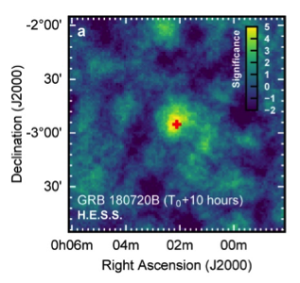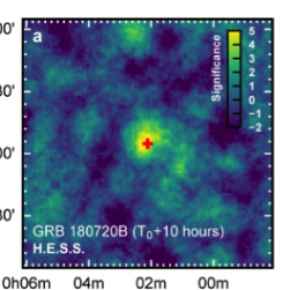
First detection of very high energy gamma-ray bursts
The most violent cosmic explosions in the Universe give rise to gamma-ray bursts, very short yet highly energetic flashes of photons. Two of them have now exceeded the highest energy levels ever observed until now, confirming that these gamma-ray emissions can reach energy levels at least a trillion times higher than that of visible light. The observations provide, for the first time, evidence of the presence in gamma-ray bursts of particles accelerated to extreme energies. They also show that the particles still exist, or were created, a long time after the initial burst. The most likely hypothesis is that the initial explosion gives rise to the formation of a jet of plasma which, when it encounters the interstellar medium, slows down, creating a shockwave that acts as a kind of ‘cosmic particle accelerator’. The findings were obtained by international research teams1 , involving in particular CNRS scientists through the participation of various observation instruments2 , and are presented in three papers published in the journal Nature on November 20, 2019.

© Abdalla et al./H.E.S.S. Collaboration
- 1In France, researchers worked in the Centre de physique des particules de Marseille (CNRS/Aix-Marseille Université), the Centre d'études nucléaires de Bordeaux Gradignan (CNRS/Université de Bordeaux), the Institut de planétologie et d'astrophysique de Grenoble (CNRS/Université Grenoble Alpes), the Institut de recherche sur les lois fondamentales de l'Univers (CEA), the laboratoire « Astroparticule et cosmologie » (CNRS/Université de Paris), the laboratoire « Astrophysique, interprétation, modélisation » (CNRS/CEA/Université de Paris), the Laboratoire d'Annecy de physique des particules (CNRS/Université de Savoie Mont Blanc), the Laboratoire de physique nucléaire et de hautes énergies (CNRS/Sorbonne Université), the laboratoire « Galaxies, étoiles, physique, instrumentation » (Observatoire de Paris - PSL/CNRS), the Laboratoire Leprince-Ringuet (CNRS/Ecole polytechnique), the Laboratoire Univers et particules de Montpellier (CNRS/Université de Montpellier) and the Laboratoire Univers et théories (Observatoire de Paris - PSL/CNRS).
- 2Including the H.E.S.S and MAGIC telescope arrays.
A very-high-energy component deep in the γ-ray burst afterglow. H.E.S.S. Collaboration, Abdalla et al. Nature, November 20, 2019.
Observation of inverse Compton emission from a long γ-ray burst. Veres et al. Nature, November 20, 2019.
Teraelectronvolt emission from the γ-ray burst GRB 190114C. MAGIC Collaboration, Acciari et al. Nature, November 20, 2019.


